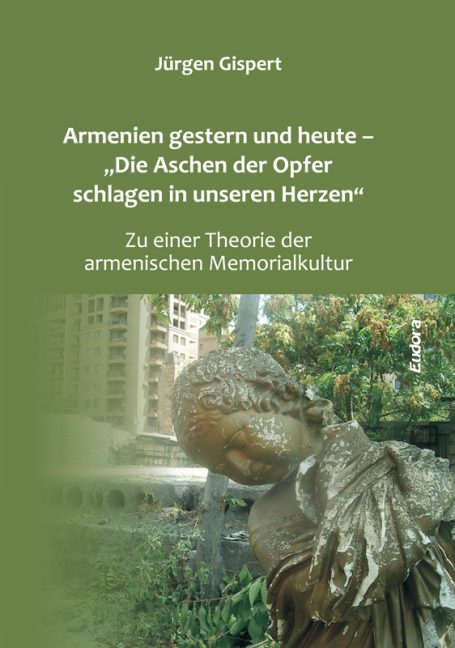Description
Interview with Jürgen Gispert about his book,
prodcasted by RadioBlau Leipzig, 27/08/2022, 4:00 PM
Who is how commemorated?
This book presents the results of a long-term research on Armenian culture, in which the significance of the eventful history and the specific characteristics of the collective memory are particularly striking. This might illustrate the example of the monument, which generally can be imagined as a "time machine" which helps to bridge and objectify the separation between the living and the dead. The Genocide Memorial in Yerevan – its history, structural components, and the associated ritual on April 24 reveals the peculiarities of the collective memory of the Armenians: the influence of many cultures, autochthonous cultural characteristics, political and socio-economic dependencies, ethnic areas of tension and catastrophes, as well as ritual patterns of action and communication. In this way, the conditions under which Armenian identity and memorial culture develop become tangible. At the same time, it becomes clear how extraordinarily important it is to deal with cultures of commemoration, as they not only reject, but at the same time are instructions for current and future actions, too. Because the ashes beat in the hearts, the memory of the innocent victims is reconnected with the grief about them, but also with the call for legitimate revenge and the fight for the freedom of the fatherland.
The introductory chapter presents the situation at the end and beginning of ethnological research and goes over the resulting boundaries between the researcher and the stranger.
Chapter 2 presents Armenian history and in this way shows, how internal and external perspectives depend on each other. As the Armenians got in touch with other cultures (Greeks, Parthians, Ottomans) the following phenomenon occurs: The strange surrounds the own like concentric circles and supplements it as its opposite. On the other hand, however, the foreign often appears in the center of the smallest circle – as the innermost of one’s own. Elements taken from the outside world do not replace one’s own cultural elements, but complement them. The following patterns of action emerge: imitation/assimilation, masking, supplementation, and incorporation. In addition, relationships are to be established that are constitutive for shown and hidden culture.
The third chapter deals with the memory theorists Maurice Halbwachs, Jan and Aleida Assmann, and Pierre Nora. Based on their theoretical approaches, we discover constitutive elements for (collective) memory/memories, as well as relations between individual and society/collective, tradition and modernity, medium and message. In this context and with recourse to the knowledge gained in the history chapter, monuments can be analysed, whereby the outstanding position of art and music in Armenian culture is taken into account – exemplified by the Cross-stone, which is particularly important in the process of remembrance, and by the music of Komitas and Chatchaturyan. In this way, the conditions under which Armenian identity and memorial culture develop become tangible.
The fourth chapter is dedicated to the Genocide Memorial in Yerevan – its history, structural component, and the ritual associated with it on April 24. The bitter dispute over the Armenian genocide in 1915 and its recognition primarily concerns the relationship between Turkey and the Republic of Armenia, but actually goes back further and includes European history. This already can be seen in the history of the term “genocide”, which is closely linked to Rafael Lemkin, and regarding to the introduction of the term into general international law. The discussion must go beyond the events of 1915, and has to offer explanatory models for current developments, for example with a view to Nagorno-Karabakh.
2022, 492 pages, 15 ill.., 36 plates (incl. 8 maps), hardcover, 17 x 24 cm
ISBN: 978-3-938533-77-2


![Prosopography of travelers and immigrants to the Ottoman Empire (1396–1611)<br><br>[Ralf C. Müller]<br><br>](https://eudora-verlag.de/wp-content/uploads/2016/05/9783938533024-300x427.jpg)
![Dying Paganism.<br>The reconstruction of the first world religion<br><br>[Bernhard Streck]<br><br>](https://eudora-verlag.de/wp-content/uploads/2016/05/9783938533383-300x424.jpg)
![Franks in the East.<br>Nature, dimensions, structure, and dynamics of migration from the Latin West into the Ottoman Empire of the 15th and 16th centuries on the basis of travelogues<br><br>[Ralf C. Müller]<br><br>](https://eudora-verlag.de/wp-content/uploads/2016/05/9783938533000-300x432.jpg)
![The “Other Gypsies”. <br>On the ethnicity of the Rudari and Boyashes in Southeast Europe <br><br>[Jens Bengelstorf]<br><br>](https://eudora-verlag.de/wp-content/uploads/2016/05/9783938533291-300x433.jpg)
![Gypsy-Islam. <br> Ethnographic research on religion in the Western Balkans<br><br>[Henning Schwanke]<br><br>](https://eudora-verlag.de/wp-content/uploads/Cover1web-300x426.jpg)
![Gypsies by the Black Sea<br><br>[Eds.: <br>Elena Marushiakova/ Udo Mischek/ Vesselin Popov/ Bernhard Streck]<br><br>](https://eudora-verlag.de/wp-content/uploads/2016/05/9783938533130-300x300.jpg)